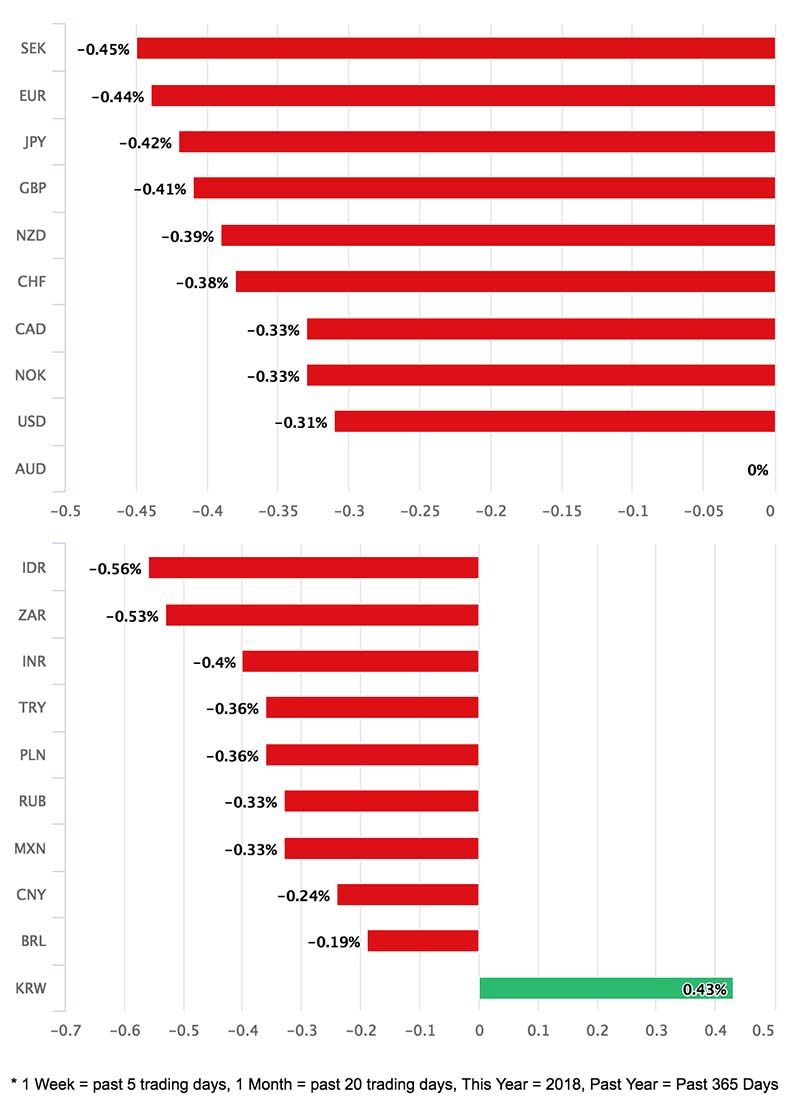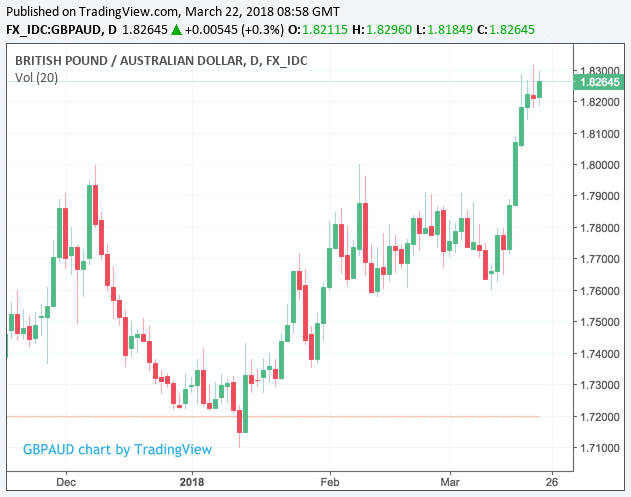Australian Dollar Down on 'Cracking' Jobs Report as Traders Dig Deeper into the Data to Uncover Concerns
- Written by: James Skinner
-
- Australian Dollar worst performing major currency today
- Economy creates "full‑time jobs at a sizzling pace"
- But markets are not convinced job report good enough to signal higher wages

© kasto, Adobe Stock
The Australian Dollar was seen lower against the Dollar, Pound and other major peers as markets reached the conclusion that the March jobs report simply did not contain evidence that Australian wages are about to take off.
Employment levels in Australia rose again in February, extending a record run of jobs gains with the headline employment figure rising 17.5K.
Australia continues to "create full‑time jobs at a sizzling pace," says John Peters, an economist with Commonwealth Bank Australia, adding "it is the cracking pace of full‑time jobs creation that catches the eye in the latest snapshot of the nation’s labour market conditions."
However markets were expecting for a rise of 20K which partly explains the Aussie Dollar's dour reaction.
Dig deeper and there were further disappointments with the unemployment rate rising to 5.6% when markets were expecting it to remain at 5.5%. The quarterly update on underemployment surprised as it rose to 8.4% in February, up from 8.3% in November.
Encouragingly, the participation rate rising to 56.7% from 65.6% as more previously inactive workers dipped their toes back into the market which goes some way in explaining the statistical rise in unemployment.
"The rise in both the unemployment and underemployment rates was, however, quite disappointing. The strength in the jobs market is clearly drawing in more workers, but ongoing labour market spare capacity suggests wage pressures are likely to remain quite muted," says Felicity Emmet with ANZ Bank.
The Australian Dollar is the worst-performing major currency in the wake of the data, falling against all top 10 peers and the majority of the top 20 group of global currencies.
The Pound-to-Australian Dollar has risen back up to 1.8260 following the report, having been as low as 1.8050 earlier in the week.
Advertisement
Get up to 5% more foreign exchange by using a specialist provider to get closer to the real market rate and avoid the gaping spreads charged by your bank when providing currency. Learn more here.
It's About Wages
The key point to understand in all this is how today's jobs report ties in with wages, as it is wages that markets are really focussed on - only when wages start rising at a robust pace will the Reserve Bank of Australia start raising interest rates which will in turn support AUD.
Recall the February Wage Price Index release confirms wages are more-or-less static in Australia with the index increasing by 0.6% in the December quarter and growth over the year rising slightly to 2.1%.
It is the dilemma on wages that currency markets are fixated on and they are betting the Reserve Bank of Australia will only raise interest rates once wages start rising in a robust fashion once again.
"Wages growth in New South Wales had been steady at around 2 per cent for a couple of years, despite the very much stronger labour market conditions in that state," says CBA's Peters. "So NSW in a way is the "canary in the mine” on this wages issue given it has been, the strongest labour market in the Commonwealth over the past year by a country mile but wages haven’t budged yet with growth stuck at an insipid 2%."
ANZ's Emmett agrees:
"The strength in the jobs market is clearly drawing in more workers, but ongoing labour market spare capacity suggests wage pressures are likely to remain quite muted."
However, it is unlikely the situation will persist indefinitely, and 2018 could see wages respond to the strong dynamics in the jobs market.
"Leading indicators continue to suggest that the labour market will tighten further. Record high business conditions and ongoing growth in job ads suggest that solid jobs growth should continue and the unemployment rate should decline further in coming months," argues Emmett.
Aussie Under Broad-Based Pressure
Concerning the outlook, signs suggest the Aussie Dollar is likely to remain under pressure.
We reported yesterday that analysts with Trade With Precision highlight GBP/AUD as one of two pairs which still have excellent bullish potential. In fact they single the pair out for special treatment in a newsletter out this morning.
They note, for example, how the pair has now finally broken above a previous glass ceiling level at 1.80, which in itself is a reaffirmation of animal spirits.
"After several weeks of finding resistance below the strong level of around 1.80, GBPAUD has finally broken above its consolidation area with strong bullish momentum and continued to push higher to place a new higher high."
The Aussie is also seen under pressure against the US Dollar.
"AUD/USD remains under pressure and is expected to retest the 78.6% retracement at .7637 and the 2016-2018 uptrend line at .7600. There it is expected to find at least short term support," says Karen Jones, an analyst at Commerzbank. "The previous support line should now act as resistance at .7764 and this guards the 200 day moving average at .7805."
The AUD/USD rate was quoted 0.27% higher at 0.7710 during noon trading in London Thursday while the Pound-to-Aussie rate was 0.21% higher at 1.8248.
“The tease of the 0.7750-00 area should end shortly after the FOMC meeting one way or another. Very weak iron ore prices are a distinct risk for the Aussie in broad terms,” says John Hardy, chief FX strategist at Saxo Bank.
Advertisement
Get up to 5% more foreign exchange by using a specialist provider to get closer to the real market rate and avoid the gaping spreads charged by your bank when providing currency. Learn more here.






